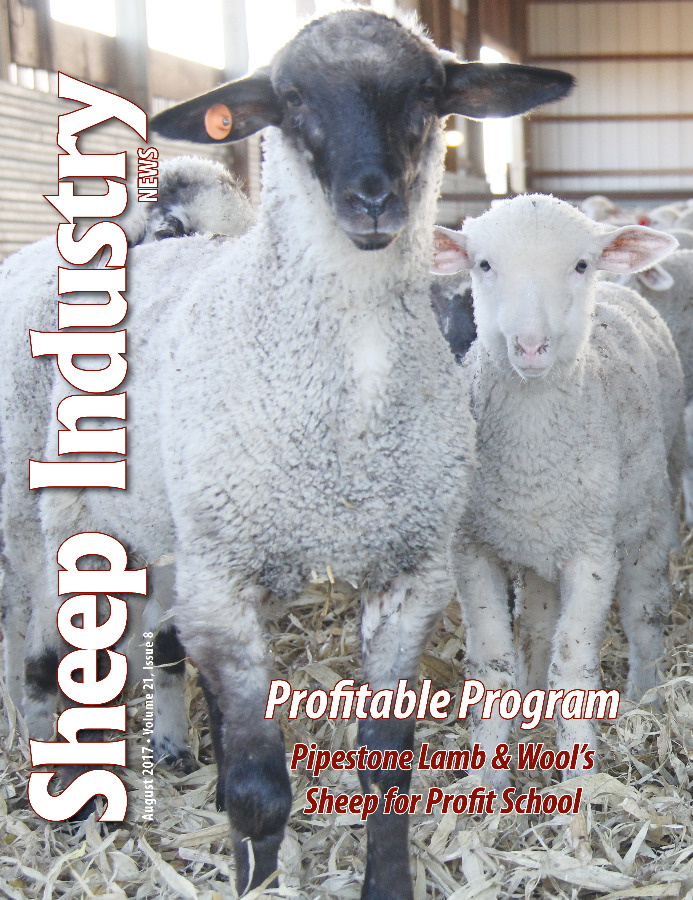NSIP, Breed Associations Plan for Future
Fall Meeting Expected to Discuss Common Goals
TERRI QUECK-MATZIE
Special to the Sheep Industry News
Improving productivity in the sheep industry rests on the ability to enhance animals’ genetic potential. For nearly two decades, the National Sheep Improvement Program has worked to advance the use of quantitative genetic selection to accomplish that end.
NSIP has the technology and the core database, but is now looking to collaborate with sheep breed associations to help assimilate information and register even more breeding stock in its database of Estimated Breeding Values.
To form the basis of that collaboration a meeting is scheduled for this fall, funded by the latest round of ASI Let’s Grow grants.
“This project will expand the use of quantitative genetic selection in the U.S. sheep industry by combining the relationship and information distribution breed associations have with their members, and the genetic analysis program operated by NSIP,” says NSIP Program Director Rusty Burgett. “Forming this relationship will expand the use of EBVs in selection decisions, increasing the productivity and profitability of the U.S. sheep industry, and allow breed associations to offer more service to their members while increasing the number of sheep being registered.”
The collaboration has been identified as a priority by the Sheep Industry Road Map, as well as a 2014 needs assessment which was performed by Demeter Communications as part of NSIP’s recent branding effort.
“It’s a model that has been proven successful by other livestock sectors, especially beef and dairy,” adds Burgett. “We arranged this meeting to start the process because face-to-face meeting is the best way to form a relationship.” Along with NSIP breed association representatives, industry partners from the commercial, feeding and packing sectors will be present to help align common production goals.
Burgett bills this meeting as the first of its kind. NSIP has been in existence since 1986, and thanks to education initiatives backed by Let’s Grow funding, the American Lamb Board and the National Sheep Industry Improvement Center, has increased in popularity in recent years.
But there are still many producers to reach with the message. And the Demeter Communications’ needs assessment identified breed associations as one of the top sources of information for producers.
“Forming this relationship will help promote the use of NSIP and advance the genetic potential of purebred sheep, which will pass on productivity improvement in the commercial, feedlot and packing sectors of the industry,” says Burgett.
This trickle down effect of genetic selection enables commercial producers to produce more lambs, reduce fat deposition, accelerate rate of gain and harvest lambs at an earlier age, while also improving the wool clip.
“By aligning seedstock providers, their breed associations and NSIP to a common goal of productivity, we improve the industry as a whole,” Burgett says. “Enhancing genetic selection provides the genetic framework to improve wool quality and quantity, as well as lamb consistency, quality and quantity produced.”
Breeds that have used NSIP’s technology have seen commercially relevant results. In the past decade:
• The Polypay breed has increased total weight of lambs weaned per ewe by 10 pounds.
• The Suffolk breed has increased market weight by 5 pounds, while increasing loin eye area and decreasing fat.
• The Targhee breed has increased total weight of lamb and wool produced per ewe by 10 pounds, while maintaining wool quality.
• The Katahdin breed has increased total weight of lambs weaned per ewe by more than 6 pounds, while increasing internal parasite resistance.
“Wider adoption of NSIP technology combined with the impact of breed associations will expedite adoption of EBVs, so these measured improvements can also be seen in commercial lamb production,” says Burgett.
The breed associations are ready and willing to do their part.
“Katahdin Hair Sheep International supports the opportunity to work across breeds to improve productivity of sheep in the United States. All breeds, as well as commercial producers, will benefit from a thriving market, more cooperation and more genetic improvement,” says KHSI President Lynn Fahrmeier. “Breed associations in the dairy and beef associations have played a major role in genetic improvement programs that have thrived in those species and production systems over the last 40 years. We look forward to this opportunity for the Katahdin breeders to participate in an industry-wide development program.”
Enrolling more producers and their sheep in the NSIP program not only provides the framework for greater productivity and profitability throughout the industry, but increases NSIP’s goal of becoming fiscally sustainable through member enrollment and, thus, less dependent on the grant system.
“As an organization, self-sustainability is our ultimate goal,” says Burgett. “With greater participation, that becomes more realistic. In addition, having more animals in our system creates more accuracy in our EBV data.”
Burgett says detailed plans for the autumn meeting will be available as the time approaches. So far Rambouillet, Targhee, Columbia, Merino, Polypay, Suffolk, Hampshire, Dorset, Dorper and Katahdin breeders, as well as any other commercially-relevant breed associations and the Dairy Sheep Association of North America have expressed interest in attending.
“This will be an excellent opportunity for sheep breed associations and NSIP to come together for a brainstorming session; yielding outcomes on how we can synergistically work together,” says Amanda Everts, Executive Secretary of the United Suffolk Sheep Association. “The sheep industry can greatly benefit from this conversation and utilizing quantitative genetic selection.”
There’s no doubt the industry must work together. “This is all about taking things to the next level,” says Burgett. “It’s time to include the industry as a whole if we want to improve the industry as a whole. NSIP wants to do that. And the breed associations, representing their members, want to do that. It should be an interesting meeting and a win-win for everyone.”


